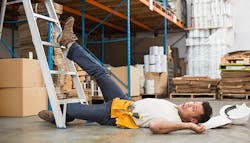New OSHA Slip & Fall Rules Impact Employers in All Industries
Employers in every industry now face stringent federal rules governing slip and fall prevention that until recently applied only to the construction business.
Mostly going into effect on January 17, 2017, the rules finalized by the Occupational Safety and Health Administration (OSHA) cover equipment and practices designed to prevent slips and falls in the workplace, focusing primarily on the training, use and maintenance of protective equipment.
It is important for those in the logistics industry to note that the rules specifically exclude work involving railroad rolling stock and commercial motor vehicles, including trucks and busses, largely because of objections raised during the rulemaking’s comment period that asserted OSHA lacks legal jurisdiction over this kind of work.
However, the agency disagrees with the view that current federal laws regulating trucking and railroads block OSHA from acting on its own in this area, and said it plans to issue rules regarding this kind of work in the near future.
The final rules will have a wide scope of impact by establishing new requirements for all general industry pertaining to the use of walking-working surfaces, such as floors, stairways, ladders, dockboards, roofs, scaffolds, and elevated work surfaces and walkways.
OSHA claims that 112 million workers employed at 7 million worksites will be covered by the new rules. Before they were issued, the agency had been strictly enforcing similar rules only in the construction industry, where the largest number of slip and fall injuries and fatalities occur.
According to OSHA, the final rules will increase consistency between general and construction industries, which it believes will help employers and workers in both industries.
“Because a key motivation for the rule was to keep pace with technological advancement and national consensus standards, employers who have adopted those standards may be largely compliant already,” say attorneys Mark Duvall and Jayni Lanham of the law firm of Beveridge & Diamond.
As the agency notes, many conscientious employers already follow most of these practices. What goes unsaid is that workers’ compensation and other insurance costs, state workplace regulation—and the ever-present threat of tort lawsuits—already act as a powerful incentive in this area for even reluctant employers.
However, OSHA estimates that its new rules will prevent 29 fatalities and more than 5,842 injuries annually. Originally proposed in 2010, the rules become effective on Jan. 17, 2017, with some portions of them going into effect after that—in one case a full two decades later.
“The final rule will increase workplace protection from those hazards, especially fall hazards, which are a leading cause of worker deaths and injuries,” says OSHA chief Dr. David Michaels, who is Labor Department assistant secretary for occupational safety and health. “OSHA believes advances in technology and greater flexibility will reduce worker deaths and injuries from falls.”
What Employers Need to Do
The agency says the new rules will allow employers to select the fall protection system that works best for them by choosing from a range of acceptable options, including personal fall protection systems. OSHA has permitted the use of personal fall protection systems in construction since 1994, and the final rules adopt similar requirements for general industry.
OSHA said other changes include revised requirements for fixed and portable ladders; allowing employers to use rope descent systems up to 300 feet above a lower level; prohibiting the use of body belts as part of personal fall arrest systems; and requiring worker training on these systems and equipment.
Under the rules, employers can select one or more of several options, depending on the particular situation or activity involved. Options include: guardrails; safety nets; personal fall arrest systems (although body belts are now banned); positioning systems; travel restraints; ladder safety (not including cages or wells); handrails; and designated areas (only permitted on low-slope roofs).
The general ladder safety requirements apply to both fixed and portable ladders, along with mobile ladder stands and platforms. Exempted are ladders used in emergency operations and those that are an integral part of machines or equipment.
Employers must ensure that ladders are capable of supporting at least the maximum intended load, which is the total weight and force anticipated to be applied by employees and equipment or other materials. Mobile ladder stands and platforms must be capable of supporting four times the maximum intended load.
Also, all ladders must be inspected before initial use during a work shift, and as often as OSHA deems necessary after that, to identify visible defects that could cause worker injuries.
Special requirements for portable ladders include slip-resistant rungs and steps, and finding ways to secure and stabilize use on slippery and other potentially dangerous surfaces. OSHA says ladders may not be placed on unstable bases to add height or fastened together when they have not been designed for such use.
Training and More Training
Employers must train workers who use personal fall protection equipment or who work in circumstances where they risk slips and falls—including working on loading docks. Workers must be trained by what OSHA deems to be a “qualified person,” and the training must be understandable to all employees, including those speaking languages other than English.
The required training must cover areas such as the identification of fall hazards and the proper use of personal fall protection systems, as well as the maintenance, inspection and storage of equipment used for fall protection.
Employers also must ensure the retraining of workers when they have reason to believe that the employees lack the required normal comprehension and skill, OSHA stresses.
The effective dates of some provisions of the rules are delayed and will become effective on the following schedule:
• Fall hazard training and training for workers using equipment covered by the final rule: May 17, 2017.
• Inspection and certification of permanent anchorages for RDSs: November 20, 2017.
• Equipping existing fixed ladders over 24 feet with a cage, well, personal fall arrest system, or ladder safety system: November 19, 2018.
• Installing personal fall arrest or ladder safety systems on new fixed ladders over 24 feet and replacement ladder or ladder sections: November 19, 2018.
• Replacement of cages and wells with ladder safety or personal fall arrest systems on all fixed ladders over 24 feet: November 18, 2036.
Attorneys Duvall and Lanham note that OSHA’s action flouts recent Republican warnings to President Obama against issuing new final rules in the wake of the election results. “Thus, although its substance has generated less controversy than many other rules adopted under the Obama Administration, OSHA’s new rule faces an uncertain trajectory,” they observe.
But in this case no one knows what the Trump Administration will do—leave the regulations intact or choose not to enforce them while reopening the rulemaking to incorporate more employer input into the final version. Because of a long-time federal law governing the development of these kinds of regulations, the new President can’t simply order them withdrawn after they were made final.
When it comes to congressional action, attorney Andi S. Kenney of the law firm of Jenner & Block doesn’t believe that the new Republican Congress will try to overrule the rules using the Congressional Review Act, which allows lawmakers to block any new federal rules within 60 days of their adoption.
“That action is risky because the CRA is such a blunt instrument,” she points out, noting that “the CRA can only be used to repeal a regulatory act in its entirety; it cannot be used to amend the regulations.”
To learn more about what the rules cover, visit OSHA’s website.
About the Author

David Sparkman
founding editor
David Sparkman is founding editor of ACWI Advance (www.acwi.org), the newsletter of the American Chain of Warehouses Inc. He also heads David Sparkman Consulting, a Washington D.C. area public relations and communications firm. Prior to these he was director of industry relations for the International Warehouse Logistics Association. Sparkman has also been a freelance writer, specializing in logistics and freight transportation. He has served as vice president of communications for the American Moving and Storage Association, director of communications for the National Private Truck Council, and for two decades with American Trucking Associations on its weekly newspaper, Transport Topics.
